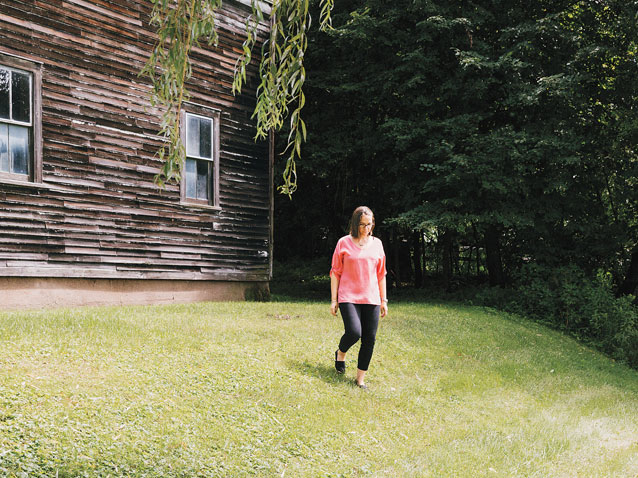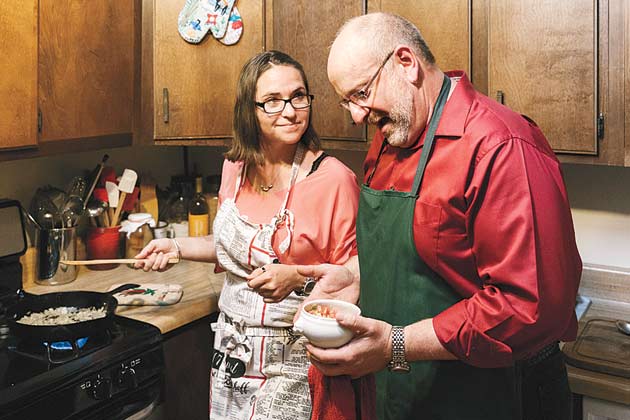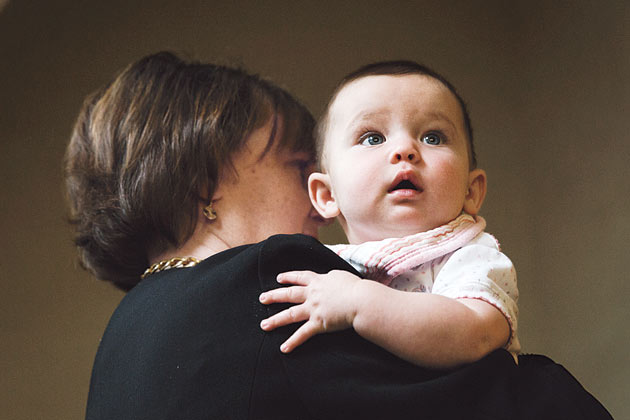After the Cure
Photos by Daniel Shea
The success of pediatric cancer therapies has a downside: adults with lingering health problems caused by their treatments.
Photos by Daniel Shea
The success of pediatric cancer therapies has a downside: adults with lingering health problems caused by their treatments.
Published On September 22, 2014
More than 25 years ago, the parents of three-and-a-half-year-old Sally Ekus overheard her warning her dolls, “You’ll die if you don’t take your pills.” Sally was on a drug holiday from treatment for her life-threatening blood cancer, acute lymphoblastic leukemia. To ease her mind about being off the drugs, her parents gave her a daily vitamin until she resumed therapy.
After 27 months, Sally was finally finished with her treatment. She grew up, played sports, went to college, got a job. It was a miracle. But a few years ago, talking with other survivors of childhood cancer, she began to wonder whether the drugs that had saved her life may also have compromised it. “I don’t know what happens today when you get a clean bill of health, but then there wasn’t much discussion about what to do afterward, what the long-term effects of your treatment might be, what to prepare for.”
For years she suffered debilitating stomach pains and has a severe intolerance to broad nutritional categories (gluten, dairy) as well as to mustard and other specific foods. Batteries of tests have failed to pinpoint the problem. “I don’t know whether any of this is directly related to my chemotherapy,” she says.
But for other survivors of childhood cancer, the link between life-saving therapies and problems that appear during young adulthood is becoming increasingly clear. In 1984, Allison Margolies celebrated her fourth birthday in the hospital, where she received a bone marrow transplant. (Her baby sister was the donor.) It was the last hope for treating her chronic myeloid leukemia, then virtually incurable. Doctors had advised her parents simply to enjoy what they said would be Allison’s last year of life. Instead, her parents took her to Dana-Farber Cancer Institute in Boston, where pediatric oncologists were developing controversial combination therapies for children. The tiny girl received four chemotherapies plus total-body irradiation before the bone marrow transplant.
The treatments killed her cancer cells but also weakened her bones, and she had to have pins implanted in her hips at age 10. The therapies stunted her growth and gave her fatty liver disease (more commonly seen in alcoholics) when she was in her 20s, about the time benign tumors in her ovaries and uterus led to a hysterectomy. “The medication that saved my life also made it impossible for me to create life,” she says.
There are now some 380,000 survivors of childhood cancer, and most are under age 40. That’s one of every 600 or so young adults—a growing population that testifies to a revolution in treating pediatric cancers, which had been routinely fatal until the 1970s and ’80s, when new combinations of high-dose chemotherapy and radiation began to increase the survival rate, which has risen to a range of 66% to 97%. But the medical world began to see an alarming number of “late effects”—developmental and cognitive problems, infertility, heart disease and hypertension, lung disorders, bone fractures, frailty and secondary cancers.

Because Allison had so many of those problems so early in life, her condition has been followed in a long-term survivorship program. Her oncologist, Howard Weinstein, has since moved from Dana-Farber to MassGeneral Hospital for Children, where he is chief of pediatric oncology. She receives a mammogram and breast MRI annually, and twice a year her skin is examined. Because radiation and chemotherapy can also damage the heart and lungs, she gets yearly EKGs and has echocardiograms and a lung function test every year or two. So far, the tests have uncovered no new issues, “but I know I have to stay on top of this,” she says.
But Allison, with her health so closely monitored, is an exception. “Well over half of the survivors of childhood cancer are not being followed in a long-term survivor program,” Weinstein says. Those former patients may not realize they’re at risk of developing serious health conditions very early in their lives, and their physicians won’t know that they should order diagnostic screenings that would otherwise be inappropriate for someone under age 60.
“A mentor taught me that cure is not enough,” says John M. Maris, who directs the Center for Childhood Cancer Research at The Children’s Hospital of Philadelphia. “We sometimes forget that this young person we’re treating may have an incredibly long life. It’s our responsibility to address the totality of that life span rather than just getting rid of the cancer. What is it like to grow up after getting fairly toxic therapy early in life?” More and more research is focused on answering that question.

In 1994, the National Cancer Institute established the Childhood Cancer Survivor Study to analyze the health of more than 14,000 survivors treated for childhood cancer between 1970 and 1986. For comparison purposes, the research also looks at 4,000 siblings of those young patients. A follow-up study analyzes 14,000 survivors whose cancers were found between 1987 and 1999 (and another 4,000 siblings), a period during which more sophisticated treatments were introduced.
This trove of data suggests that three out of four childhood cancer survivors will develop chronic health problems within 30 years, and almost half will have severe, disabling or life-threatening problems. Survivors are eight times as likely as their siblings to have heart attacks, congestive heart failure, infertility, additional cancers and severe cognitive problems.
The likelihood and severity of late effects is directly related to how much chemotherapy or radiation a young patient received. The higher the cumulative dose of drugs and the more extensive the radiation, the more problems there are likely to be. Some widely used chemotherapies, including alkylating agents and anthracyclines, are particularly prone to cause late effects.
Cancers affecting the brain and spine are particularly difficult to treat in children without compromising their future. “We have some cures for brain tumors that we won’t use with children under age five because we can’t justify the devastating neurological effects,” Weinstein says. “A child’s IQ may drop from 110 to 60.”
And girls may suffer more long-term effects than boys, in part because of the risk of breast cancer. “Especially in girls going through puberty, chest irradiation increases the risk of breast cancer for decades after completion of therapy,” Maris says. And female survivors of childhood cancer have a 10% to 20% chance of breast cancer before they turn 40. That’s about the same risk as for women who have mutations in the BRCA gene—a well-known health issue that leads some women to have their breasts removed to forestall the disease. The median age at which childhood cancer patients are diagnosed with breast cancer is 35, compared with a general population in which 95% of diagnoses are in women over age 40 and the median age is 61.
Late effects are also more likely for those who’ve had particular cancers. Brain and spinal tumors cause some of the worst problems, including cognitive deficits, neurological problems, complications with the endocrine system, stunted development, seizures, weakness, blindness and hearing loss—and loss of independence as adults.
Three other cancer types also carry particularly high risks for survivors: Hodgkin’s lymphoma (radiation treatment to the chest damages the heart, arteries, lungs and sometimes the digestive system), Wilms’ tumor (this affects the kidneys, with radiation hurting gastrointestinal areas), and bone cancer (radiation may cause life-altering problems with muscles and bones). Some late effects are very specific. Survivors of Hodgkin’s and Wilms’ often get cancers of the gastrointestinal tract. And radiation to the neck of a child before puberty stops the muscles from growing, leading to noticeable deformities.
Heart disease has turned out to be a major problem. Radiation to the chest can damage the heart, coronary arteries and valves. So can some kinds of chemotherapy. One of every two kids with cancer is treated with anthracyclines, and more than half of those who receive it are likely to develop heart disease. “This is a population we are now suddenly seeing,” says Sanjeev Francis, director of the cardio-oncology program at MGH. “Before, they weren’t surviving long enough for heart disease to become an issue.”
Once they realized the vast scope of damage from early cancer treatments, pediatric oncologists and radiation oncologists began seeking safer alternatives. For example, children with early stage Hodgkin’s lymphoma used to get extensive high-dose radiation to the neck, chest and breast, but little chemotherapy. “That cured the kids, but 20 years later they had secondary cancers,” Weinstein says. Girls treated near puberty ended up with a 30% risk of breast cancer. “So, 10 to 15 years ago, we decided to minimize radiation and add a four-drug chemotherapy to keep the cure rate high,” he says. Similarly, pediatric leukemia patients once routinely had radiation directed at the brain. “Now we understand that we can give chemotherapy through a spinal tap,” says Tara Henderson, medical director of the Childhood Cancer Survivor Center at the University of Chicago. That has improved cure rates significantly while helping avoid cognitive problems.
Radiation treatments themselves have been transformed, with new methods focusing standard X-rays more narrowly or using proton beam radiation to avoid destroying healthy tissue. While proton therapy is more expensive than X-rays, proton beams deliver most of their energy directly to a tumor, minimizing collateral damage.
To reduce the risk of heart problems, radiologists try to spare the heart and its arteries. Anthracyclines, which also damage the heart in ways researchers are still trying to understand, continue to be a mainstay of pediatric cancer treatments, but oncologists now attempt to keep the cumulative dose of anthracyclines below a threshold based on a child’s age and size to minimize later heart damage.
For children who get anthracyclines and other potentially heart-damaging treatments, subsequent screening could help catch heart disease early. But how often should survivors receive screening tests for heart disease and which tests are the most appropriate? Francis says that patients who receive the treatments at five “could have heart disease by the time they’re 25.” That’s a lot of years of screening, and research efforts led by Marielle Scherrer-Crosbie and Tomas Neilan of the MGH cardio-oncology program are looking at whether standard advice for reducing heart risks—taking aspirin, statins or ACE inhibitors, as well as eating right, exercising and not smoking—as well as regular monitoring of the heart with imaging or blood tests might improve the odds for these patients.
Surviving childhood cancer often takes an emotional, psychological and social toll. “Some kids aren’t even told they had cancer, but they know they’re different,” says Patricia Ganz, a prominent researcher in cancer survivorship at the Jonsson Comprehensive Cancer Center at University of California, Los Angeles. “Others are constantly having follow-up tests or are in the hospital for side effects. They may miss a lot of school and not be able to play sports. Their parents may be very protective.”
Perhaps as a result, childhood cancer survivors are less likely than others to graduate from college, find jobs, and get and stay married. Those who overcame cancer of the central nervous system fare worst by such measures. There may be survivor guilt when others in the oncology unit die, Weinstein says, and survivors have high rates of suicide. “When patients attend our survivorship clinic they see the psychologist first and then the physician and nurse,” Ganz says.
Most major cancer centers now have survivorship clinics to serve as way stations between oncology and the fragmented world of general medicine. “These young adults need someone to help them navigate the system,” Weinstein says. “We can help them make the transition to primary care physicians who truly understand what survivors need.”

In a 2003 report, the Institute of Medicine called for long-term studies into the effects of past and current treatments for specific cancers, and more recent recommendations from the National Cancer Institute’s Children’s Oncology Group seek to improve how survivors are cared for. They call for all survivors to have a care plan summarizing their cancers, the treatments they received, the expected late effects, and recommended screenings and follow-ups. Yet many of today’s survivors, including Sally Ekus, still don’t know how they were treated or what to look out for now. “I didn’t think anyone noticed, cared, or that it even mattered what happens after you get the cured card,” she wrote on a blog. “It never occurred to me to look back, to request my medical files and start back at the beginning” when she experienced gastrointestinal problems. She’s now volunteering at the Leukemia & Lymphoma Society to increase awareness among other young survivors and to support research into quality-of-life issues and less toxic therapies for children.
But she is also quick to say that her health issues are good problems to have. “I’m so incredibly grateful for everything that I’ve been able to experience after my cancer diagnosis,” she says. “There are still challenges, but I’m so appreciative that people are exploring what it means to be a childhood cancer survivor.” Allison Margolies, too, is “happy for every day” and grateful that she and her husband now have a daughter through the help of a gestational carrier.
Pediatric oncologists celebrate along with their patients when a course of treatment restores a child to health. After all, a long survivorship, even one with elevated and uncharted risks, still counts as a win, and many patients avoid later problems, beating the odds. Helped by new research, and the treatment protocols it spawns, their numbers may grow. “The past few young adult survivors I’ve seen in our survivor clinic are all healthy,” Weinstein says. “They were treated at seven, and now they’re 40. We were worried that one young man would be infertile but he has five children. It took him a couple of extra years to finish medical school because of paternity leave.”
Dossier
“Achieving High-Quality Cancer Survivorship Care,” by Mary S. McCabe et al., Journal of Clinical Oncology: Official Journal of the American Society of Clinical Oncology. A statement from the American Society of Clinical Oncology recommending more collaboration between oncologists and primary care providers.
The Children’s Oncology Group has prepared Long-Term Follow-Up Guidelines for Survivors of Childhood, Adolescent and Young Adult Cancers at survivorshipguidelines.org
Stay on the frontiers of medicine
Top Stories
Selected Reads
For decades, a tiny encampment of researchers has held that statin treatment is a hoax. In a time when contrarian views roar to life on social media, how can medicine keep minority opinions from doing irreparable harm?
Two years in deep space will subject the body to unprecedented stresses. Scientists are probing the secrets to survival.
A freak explosion tore through the quiet Nova Scotian city, prompting one of the most dramatic medical responses in history.
We use cookies and other tools to enhance your experience on our website and to analyze our web traffic. For more information about these cookies and the data collected, please refer to our Privacy Policy.